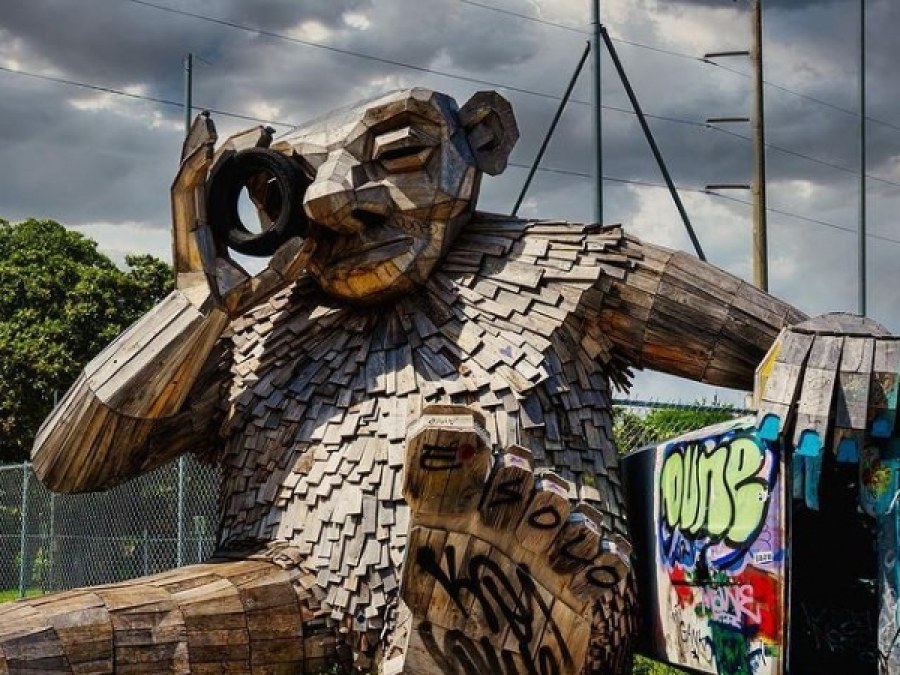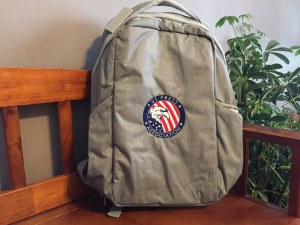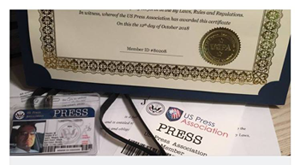
By Vince Rubiera
Long ago, people believed that spirits inhabited the forests and wildlands around us, protecting them and their inhabitants from all manner of threats. Now, in the modern era, we know what the threats are and they come from man-made climate change, environmental degradation, and waste. It’s hard to deny humanity’s impact on the world around us, but it seems somewhat more difficult to grasp just how big the problem is - and how gigantic our guardians need to be.
Constructed out of wood and in larger-than-life proportions, one troll in Wynnwood not only fits the description of a forest protector but also has some touches of modernity evident here and there with colorful nails resting on an overturned car on a Miami street corner. Created by Thomas Dambo from recycled materials, this troll, named Joenm “is fascinated by cars, and seems to have a curious yet peaceful nature.”
The choice of trolls both conforms to and breaks away from the Nordic tradition that Dambo is referencing. In Nordic legend, trolls are far from benevolent, kind creatures. Often the stuff of nightmares and warrior legend, trolls have a dark, violent nature that posits their position as the “guardian” of a wood alongside a spirit uncompromising in its duties.
Two other trolls join Joen in Miami and they are located in Pinecrest Gardens. Beyond the borders of the Sunshine State, Dambo’s trolls are found throughout Europe, the United States, and even in Asia. In each case, the approach to the piece is the same: Utilize reclaimed wood or recycled materials, construct a larger-than-life guardian edifice, and position the troll in a way that is inviting, friendly, and eye-catching all at the same time.
As for the artist himself, Thomas Dambo was born in Odense, Denmark in 1979 and has created art all over the world. Some of his more famous works include the Birdhouse Totem in his home of Odense, the Remake Utopia in Copenhagen, and Steve the Shark in the Gold Coast, Australia. He maintains a website portfolio that also lists the various locations of his trolls around the world (among other works). He also maintains a YouTube channel where he details his projects and journeys across the globe.
The trolls are part of a larger work by Dambo called “Den Kæmpestore Troldefolkefest” or The Great Troll-Folk-Fest. Detailed in a YouTube video in which he explains his work, Dambo aligns his project with the greater movements facing the world in terms of ecological awareness.
For one, Dambo’s project is not so much about changing habits as it is about bringing awareness to those practices in the first place. Often messages about green living and the need to preserve the environment are presented as binary choices with failure to comply hinting at some kind of moral lapse or lack of character; Dambo’s approach is to utilize what is beautiful, mysterious, and unique about nature in light of the modern world and how we interact with it.
https://trollmap.com/
https://www.youtube.com/watch?v=J2n8FxhunV8
[Submitted by Vince Rubiera]

By Vince Rubiera
There’s little doubt that Miami is changing - and fast.
But one neighborhood, in particular, that is noted for its boho-chic aesthetic and thriving art scene could lose its identity during this process of economic change and growth.
Of course, we’re talking about none other than Miami’s own Wynwood, the city’s version of the Bronx or Brooklyn, and that is experiencing similar levels of gentrification as those two sister boroughs of the Big Apple.
Namely, current residents and advocates for Wynwood worry that the arrival of commercial franchises and big-name brands could squeeze out the local haunts and mom-and-pop shops so key to the neighborhood’s identity. Wedged between Brickell, Downtown, Edgewater, and Miami Beach to the east, Wynwood is one of the last places in Miami where “normal” people can live, work, and play.
Yet commercial development and a drive to catch up with the rest of the city could transform the neighborhood into yet another strip of luxury glass terrariums and luxury shopping destinations.
One sign of the changing times manifests itself in the neighborhood’s iconic art murals. Typically devoted to social commentary and depicting events within the community and abroad, the push to add “commercial” art murals to the walls of Wynwood has touched a nerve with some people. After all, how much artistic value does a mural promoting a Netflix show about Selena have? Where is the social commentary?
How is this different than a billboard? To be sure, there are many reasons why property owners and businesses in Wynwood might welcome the changing demographics in the neighborhood. For one, South Florida’s real estate market is booming like never before and the demand for luxury high rises is at a peak.
It’s hard to imagine that Wynwood hasn’t looked around at its neighbors and noticed their spectacular economic growth over the past twenty years as well as how much this has changed the landscape of the neighborhoods themselves. Still, the question remains whether this is the right path for Wynwood and, further, how much culture and history Miami might lose in the process of becoming another Brickell City Center or Paraiso Bay.
Still, the COVID-19 pandemic and subsequent shutdowns have shown many in Miami just how fragile the local economy can be and how hard it is, especially for small businesses, to survive in such an environment. Towards that end, arguments for economic diversification and gentrification within reason do have some traction.
Proponents of this middle way want to find a path towards preserving Wynwood’s unique character while also meeting market demands for new housing, shops, and job opportunities. Plus, there’s a bit of not wanting to be left out of the general vibe that is lifting Miami into the top echelons of America’s most powerful cities and Wynwood’s unique position as a cultural destination and landmark could bode well for its status in a new, much more international Miami.
[Submitted by Vince Rubiera]
Potential Injuries of the Zombie Apocalypse.
Published on February 10th, 2021
In the quest to prepare my listeners for whatever Mother Nature, or the nut jobs in Washington DC, might throw at us, that conversation should always start with identifying the “worst-case” scenarios, to ensure that if you get anywhere close to that, then you’ll be prepared for those less horrible. In a similar manner to the awesome guys and ladies of ZERT (Zombie Eradication Response Team from Las Vegas Nevada), I too use the term Zombie to capture the fear and uncertainty that accompanies natural or man-made disasters, whatever they might involve. While there always seems to be people wandering around aimlessly after a sizable event, some even chanting unintelligible English, the idea that natural disasters strike suddenly, typically throwing ideas of order and planning in the destroyed toilet. During natural disasters there are many injuries that can’t be avoided, however there is substantial list of injuries that can be avoided altogether. It is primarily because of my workplace safety experiences that I have added the fifth element to my version of the fab-five (rule of three plus one). For those of you who just tuned into the show, the fab-five is one of the mantras you will hear many times, and essentially it is the rule of three plus the one I added because of its importance, protective equipment.
Greetings my friends, family members, fellow Alaskans, and fellow Americans, wherever you are. Thankfully the new administration took the reins in Washington DC without too much incident. Today we are happy to report that the vaccine distribution is going much better with the new administration being much more ambitious at the end goal. While the new team driving the country seem to be sorting themselves out, Americans seem to remain as divided as they were before the election. Welcome to the Alaska Outlaw podcast, I am the Alaska Outlaw, and I hope to be your host on a journey of understanding the types of injuries can be expected during any type of large scale event. A kind of explanation to put the “rubber on the road” for that first aid manual we all read.
In the whole mindset of being prepared, we will find that it will be those insignificant injuries that become the most catastrophic. This is really when the small, goes big and bad. When small nicks on nasty things can lead to losses of limbs, or even death of the victim. Human’s greatest enemy is violating the sanctity of our skin and introduce an infectious foreign body into the human body. Even minor infections can be lethal, and can cripple even the best prepared or healthy. In today’s episode I want to look at the potential of the most probable injuries we’ll encounter during one of these zombie events, and evaluate the reality of not having antibiotics because of one reason or another. Obviously in the case of a Zombie Apocalypse or civil war, and even during a large scale natural event, the healthcare system will be overwhelmed, or ineffective in providing services.
So, essentially our introductions to injury types will be limited to the most probable, again, evaluating the potential for recovery without the use of modern medicine, or the health care system as a whole. With no further ado, let’s look at the most frequent injuries.
3. Broken bones are a fairly straight forward injury, and occurs in a multitude of ways. The list of these types of breaks is lengthy, however for our discussion today, I’ll identify two types: inside the skin, and protruding through the skin to reveal the bone outside the skin surface.
8. 8. 8. 8. 8. Lacerations and abrasions. For those of you knowledgeable here, old news, but for some you will need to know the difference. A laceration is a cut, how deep, and how long is not nearly as crucial as where it happens. There are several locations on the human body where even a slight laceration can be very problematic. Abrasions on the other hand are more severe “scrapes”, and while typical much more shallow, they can expose more of the epidermis. Abrasions are typically more prone to infections because of the larger surface area involved.
14. 14. 14. 14. 14. 14. Punctures are the next on the list, and can be very problematic due to the item impaled with, the object potentially has more contact space with internal organs, and/or deep tissue. This fact allows it to leave more foreign substances inside the human body, thereby potentially depositing more infectious materials deep within the body.
15. Biological infections. This one is incredibly difficult to eradicate after its introduction. While the contact area inside the lungs is a direct path to the blood stream, leading to all parts of the body. Without going too far down the fear mongering rabbit hole here, there are many biological agents that can be absorbed through the skin with essentially the same results as if inhaled directly. The immediate dissipation throughout the human body makes it much more complicated to track down and eliminate. In the exact same way that through the skin type of infections immediately begin the tissue surrounding the wound, biological agents begin to attack the internal tissues.
16. Weather related injuries. This injury is obviously dependent on the environmental weather conditions at the time of the event and immediately after. The reality of these types of injuries typically cause death to the afflicted tissue, and in some cases, loss of limbs, or death. As this tissue dies, it has the potential to cause levels of infections to the adjacent tissue. In addition, to a degree, while they may be immediately avoidable, long term exposure may defeat almost all forms of protection.
Again, these are the bigger types, or high volume injuries in a disaster type event. First-Aid following a natural disaster, or in this case, the Zombie apocalypse is really where reading your basic first-aid book is coming to come in handy. Again, I’m calling out the term “zombie” to identify a threat against humankind here, and not identifying the mindless drones of Washington DC, err, movies. Although many emergency room doctors and nurses will tell us that, the hardest patients to treat is a family member, or their self. Keep this in the forefront of your mind as you and your family begin the assessments following a large-scale event.
But, here you are. In reading any first aid book, it will tell us the first things to focus on are the A, B, Cs. Airway, Breathing, and Circulation. So, is there airway clear? Are they breathing? Do they have a pulse? If you have any questions here, consult the little booklet that comes with a decent first aid kit. Not going to travel down the actual manual.
Suffice to say, let's talk about the field dressing of the injuries we identified before, and in essentially no particular order, some basic care ideas.
1. Bleeding from lacerations, abrasions, and puncture. Just like the firsts aid book says, we need to apply direct pressure to the would with enough dressing to completely cover the wound. Once the bleeding is stopped, determine if stitches and/or a butterfly bandage needs to be applied. After the bandage is applied, apply natural honey over the entire wound. Keep the area clean and dry otherwise, watch for redness. Now, even as an EMT we were trained to leave impaled objects in place bandaged there, then transport to local hospital. Depending on a mitigation of factors involved, this remains the best choice. Depending on the area, and the item impaled with, it may make more sense to push it all the way through, however, that advice would ONLY apply to extremities, and even then, you run a risk of opening blood vessels, or other dangerous parts.
2. Splinting and bone setting. Both of these scenarios can be incredibly painful for the patient. Internal fractures may be separated, and therefor extreme care must be taken when attempting to reset a bone with an interior break. Externally protruding breaks can be far messier to reset. In addition, you’ll have to deal with the laceration as well. Again, my advice does not supersede a doctor, and ultimately it’s good to keep one on speed dial for moments like these. Your first aid handbook should give you enough knowledge to help the injured to the health system.
3. Infections (biological, animal). Infection is the most dangerous killer of them all. Regardless as to whether it is inhaled, ingested, or absorbed, the effect remains the same. Superficial infections do give some warning that things are right, however internal infections are not as obvious. However, don’t kid yourself, those internal infections can be quite lethal to the patient. This is where the list below may come in handy.
4. Weather related. Your trust first aid book is going to offer you some great insight here. While the ultimate idea here is get the patient out of the weather condition, and moderate their temperature. If they’re frozen, slowly warm them up, if they’re fried, slowly cool them down. Obviously even the most protected can only stay that way for a finite amount of time, so moderate the exposure to avoid getting here at all.
Ultimately, hopefully now I’ve relayed the importance of the fifth item that I added to my fab-five. Primarily, the most dangerous threat here is infection. Depending on where you are where the injury happens, the infection spreading from the site of the injury could be your biggest enemy. So, let’s take just a minute to review some natural antibiotics.
A quick online search of any medical news today (webmd.com) gives us a list of seven (7) natural antibiotics that might have some value in our longer term preps:
1. Cultures across the world have long recognized garlic for its preventive and curative powers. Research has found that garlic can be an effective treatment against many forms of bacteria, including Salmonella and Escherichia coli (E. coli). Garlic has even been considered for use against multi-drug resistant tuberculosis.
2. Since the time of Aristotle, honey has been used as an ointment that helps wounds to heal and prevents or draws out infection. Healthcare professionals today have found it helpful in treating chronic wounds, burns, ulcers, bedsores, and skin grafts. For example, results of a study from 2016 demonstrate that honey dressings can help to heal wounds. The antibacterial effects of honey are usually attributed to its hydrogen peroxide content. However, manuka honey fights off bacteria, though it has a lower hydrogen peroxide content. A 2011 study reported that the best-known type of honey inhibits approximately 60 kinds of bacteria. It also suggests that honey successfully treats wounds infected with methicillin-resistant Staphylococcus aureus (MRSA). Antibacterial properties aside, honey may help wounds to heal by providing a protective coating that fosters a moist environment.
3. The scientific community also recognizes ginger as a natural antibiotic. Several studies, including one published in 2017, have demonstrated ginger’s ability to fight many strains of bacteria. Researchers are also exploring ginger’s power to combat seasickness and nausea and to lower blood sugar levels.
4. Echinacea has been used to treat infections for many years. Native American and other traditional healers have used echinacea for hundreds of years to treat infections and wounds. Researchers are beginning to understand why. A study published in the Journal of Biomedicine and Biotechnology reports that extract of Echinacea purpurea can kill many different kinds of bacteria, including Streptococcus pyogenes (S. pyogenes). S. pyogenes is responsible for strep throat, toxic shock syndrome, and the “flesh-eating disease” known as necrotizing fasciitis. Echinacea may also fight inflammation associated with bacterial infection. It is available to purchase in health stores or online.
5. Goldenseal is usually consumed in tea or capsules to treat respiratory and digestive problems. However, it may also combat bacterial diarrhea and urinary tract infections. In addition, results of a recent study support the use of goldenseal to treat skin infections. In a lab, goldenseal extracts were used to prevent MRSA from damaging tissue. A person taking prescription medications should check with a doctor before taking goldenseal, as this supplement can cause interference. Goldenseal also contains berberine, an important component of natural antibiotics. This alkaloid is not safe for infants, or women who are pregnant or breastfeeding. Goldenseal capsules are available to purchase in health stores or online.
6. Clove has traditionally been used in dental procedures. Research is now finding that clove water extract may be effective against many different kinds of bacteria, including E. coli.
7. Some believe that oregano boosts the immune system and acts as an antioxidant. It may have anti-inflammatory properties. While researchers have yet to verify these claims, some studies show that oregano is among the more effective natural antibiotics, particularly when it is made it into an oil.
There are no guarantee for these natural antibiotics, however in reality, there is guarantee with the high powered ones of the medical community either. Therefore the Alaska Outlaw can’t promise you anything with these, however, I will say that the human race existed for thousands of years before antibiotics were discovered, so, I’m sure they must have been able to do something right. Not to mention, the first step is cleaning. By using some soap and water on the affected area, many of the weaker germs carrying bacteria and other stuff, is destroyed.
Ultimately, it is immediately following a large-scale natural disaster that we all must be prepared to fight a war of bacteria and viruses that can have just as much impact to our health as the initial event. Using basic hygiene practices can keep many of the less virulent invaders at bay, and stepping up the hygiene game puts us miles in front of our ancestors who battled these same diseases without the aid of cleanliness. A little goes a long way here, so in our quest to be prepared, basic items such as soap and shampoo, sanitizing methods (to include boiling water) can all play an integral part in keeping us healthy, and ready for whatever societal fallout may occur.
As always my friends, thank you so much for taking this time to spend with us here at the Alaska Outlaw. I am honored to be of some service, and I think we can all agree that being prepared for anything means that we prepare the basics, and adapt them to each situation. Remember, stay safe, keep your head on a swivel, and be true to who you are... peace.
[Submitted by Mark Weisman]
---
https://akoutlaw.com
Podcast Episode 012721
Published on January 27th, 2021
Each and every minute of every day, we are bombarded with messages of "learn to return". But, many times we have to ask ourselves what is necessary? How “prepared” do we need to be? After all, 80% of Americans live in urban cities with a population of greater than 100,000 residents. Yet, in many scenarios throughout the social media circus, we read stories about society imploding to unrest, or the zombie apocalypse caused by improperly cared for vaccines. So, from the real end of the spectrum, what do we need to be prepared for? Of everything I just listed, none of that. Strategies and skills necessary to survive outside our urban sprawl without our double mocha Americana with sprinkles are really what we’re looking at here.
Greetings my friends, family members, fellow Alaskans, and my fellow Americans, wherever you are. Welcome to the Alaskan Outlaw podcast, I am the Alaskan Outlaw. Today, I would like to take you on a journey in understanding how to be prepared. My hope is to prepare you for, by educating you of natural disasters. A little personal history of mine in relation to these, Growing up as a boy in Louisiana I survived both seasonal Hurricanes and infrequent Tornados where my parents acted in an appropriate manner for the times and got us all out safely. As I grew up, our family relocated to southern Arizona where seasonal Monsoon events forced residents to adjust accordingly. Finally arriving here in south-central Alaska, my married family endured earthquake events. Over the last year, like many of you, have been advised to hunker-down with many runs on our local grocery stores. These events have taught me plenty about the things necessary for survival.
Today I’d like to talk about disaster preparedness. There are three major natural disasters that we can be prepared for, so those are:
- Earthquakes
Tornados, wind storms.
Hurricanes, and flooding events. - Item 1
- Item 2
Within these three events, the first differentiation between them is the early notification or warning we might get. With earthquakes, most often than not, there is absolutely notification, and therefore we find ourselves thrust into the actual survival scenario where the survival of the next five minutes is our objective. With a tornado, or wind storm event, you may have little notice, maybe minutes or hours, so our drills need to be practiced frequently, and with a great deal of efficiency. Finally, hurricanes and flood events, you may have some time to prepare, hours or days in advance. So let’s think about for a minute, the worst-case-scenario for each of these event types. So, in today’s episode, I want to talk about natural disaster survival, versus Doomsday preparedness. One of my major concerns for many Americans is moving away from local radio and television broadcasts, typically with regard to weather. Many Americans are completely blind-sided when their favorite grocery store has been emptied overnight. This may have some powerful ramifications to any early warning that could be received.
So, we’ve covered our major event types that could intersect with our daily lives at any time, and I think that it is a really safe bet that we’ll be impacted by one of these events in our lifetimes. Now, I want to be clear and say, these discussions don’t include any of the preparedness for wilderness outings, or hikes. This is purely speaking about the urban towns and cities that many Americans call home. Let’s talk seriously about the fab-five. When talking about them, we need to understand how the events will affect each scenario. Just a review from the “rule of three” which is a crucial factor to successful survival.
Airway, and breathing. Obviously, with only a guideline of three minutes to get into an oxygen source rich enough to maintain our internal organs, this is our number one priority. So, let’s talk about how this could become problematic during an extreme weather event. While oxygen is most abundant in the lower atmosphere, there are many conditions that could cause serious issues. Air can become contaminated by many different contaminants during a substantial weather event. Sand particles, gas leaks, vehicle exhaust, burning embers, and smoke-filled air are all very likely during one of these types of events. There are many different threats contained within our air that can arise during a natural event, in addition, there are naturally occurring conditions that may make the air even more dangerous. As an example, a lack of breeze may stall a toxic gaseous cloud in one position, exposing that position to concentrated levels of whatever substance is contained. Or colder weather could trap a gaseous cloud closer to the ground for a longer period in-lieu of it dissipating, thereby exposing the residents trapped within it. What many individuals overlook is vehicles abandoned, left running. Their exhaust is not only heavier than air but lethal as well. Raw sewage may produce methane, which is noxious and potentially flammable.
All of this is the reason I encourage people to have protective masks. Although medical grades are under lock and key anymore, they are still available, as well as many templates available throughout the internet to make them. Be aware of what type of dangers lurk in your community, and plan to breathe it.
Finally, over the last year, if there is one thing we should have made note of, and that is biological conditions. This is where I classify the SARS-CoV-2 virus, and the multiple evolved strings that have now spread around the world, in this additional subcategory. Especially in these modern-day times of misinformed parents who reject most vaccines, additional threats may be lurking throughout our air supply. Just something to consider when becoming prepared in these modern times.
Three hours after a significant event, the next order of business is shelter, and temperature control. We need a method to ensure that our current residence, whatever it might be, will be adequate for the foreseeable future. Regardless of whether your shelter is inside or outside your home. So, learning what’s involved in a home inspection, as well as basic construction methods, and being able to quickly evaluate the residence or the situation for its level of safety. Given each of the events above, our expectation should be doing anything without light, or heat, as the possibility of an electrical outage is large. So, now that we a basic understanding of shelter from the weather. In some cases, there could be an issue where the first floor of your home becomes uninhabitable, such as a flooding event. In this case, relocating to another residence, such as a hotel, or emergency shelter, or even the second floor of your home may be required. So, ultimately the major consideration when dealing with shelter is a method of moderating temperature. This can be critical depending on the severity of the weather at the time of the event. As the reality of the three-hour rule starts to take effect, whether it’s heat stroke or hyperthermia, the threat can become very real, very quickly. Being able to moderate with shade, or heat, as appropriate, becomes absolutely critical.
So, with shelter and an ongoing fresh air source secured, it’s time to move on to our next necessity of clean water, and hydration. While some stockpile bottled water, therein lies a danger depending on where it's stored based on the expected natural event. So, when considering how these events could affect water is actually quite visible. When locations flood, everything from automobile wastes to toxic chemicals, to raw sewage, could end up in the water supply, thereby rendering the tap water (if it actually works) unusable. Thereby storing large quantities of water is ideal, after all, you need a gallon per person (and pet) per day, which means a house of four persons for three days is twelve gallons of water. Having a water purification system as a backup is a great idea, boiling and purifying water might do wonders for your stockpile. The other concern is consumption. Depending on the heat, or cold, additional water may be needed for use. Consider these additional requirements if you are residing in an extremely hot, or cold place. While FEMA tells us to plan for three-five days, I would suggest doubling that. In addition, think about if your family had to relocate for some reason, are the supplies handy to grab and go? The emergency shelter might not be established yet, and so you will need to be sure you can survive until then. While the general rule says three days, depending on the weather and temperature, this might expedite the need.
From the base rule of three, we have arrived at the final need of survival, and that is food and nutrition. According to that rule, we have three weeks to find food, although pets might get a little cranky after a couple of days. Be prepared. Think about having enough goods to feed your family group for about six days (give or take), as well as any pets. Also, be sure to not completely switch everyone's diet during this very highly stressed event, some comfort foods will go along way in settling children, and pets. In addition, think about calories more than actual meals, maybe the kids could live on two cans of "spaghetti and meatballs" per day until you can start getting some normalcy back. Particularly for the twelve hours following the disaster, be completely independent, by being prepared. Another note is to consider any special situations here, a ton of freeze-dried pears are useless if no one likes pears. You will also want to go easy on spicy or salty foods for the first couple of days. While calories are important, should you find yourself needing to exert your body to survive, you will need to ensure that a large part of the ingested calories is protein-based. In addition, having a small dose of glucose as part of your survival meals will ensure you have the “burst” energy necessary to accomplish the task.
Moving on to my addition to the original “rule of three”, we can look at protective gear. While protective gear is not part of the rule of three, I feel that it is equally important to the items contained within that list. Protective gear can prevent a level of discomfort during and following an event, allowing you to focus on the more important task of securing those items necessary for survival. But, it also does much more. Having a level of protection between your body and the elements helps to maintain a healthy position that can serve many advantages. However, maintaining a healthy body, and reducing a possible infection from slight injuries, especially given the potential reduction of medical services following a large-scale event.
Survival really comes down to keeping one’s wits about you as you purposely step forward in getting out of dangerous positions into that position of safety. Survival is 90% mental prepared, 10% physical supply prepared. Survival comes down to being prepared and keeping in mind that your health in good shape throughout the event. You would be incapable of providing assistance to your family and your community should you fall ill due to a simplistic infection, especially if it could be avoided.
As always my friends, I am honored and humbled that you have chosen to spend this time with us here at the Alaska Outlaw. I look forward to talking with you next week, and please don’t hesitate to drop me an email with any questions you might have. Thank you so much for tuning in, and I encourage each of you to research the information I have provided so that you can make informed decisions about the things that you feel the need to be prepared for. Remember to stay true to what you stand for, keep your head on a swivel… Peace.
[Submitted by Mark Weisman]
---
https://akoutlaw.com
Podcast Episode 011321
Published on January 13th, 2021
By: Alaskan Outlaw
Today, we, the American people, stand at a great precipice. We all stand together at the crossroads as to whether we will travel forward in time together as a strong, well-founded nation, or whether we will be fractioned off into many splinters caused by the consistent demands of a select few, fraught with conflict and violence at every turn. With a constant threat being repeatedly beat into our consciousness, where even the strong can be beaten down by misinformation and discourse that is broadcast through social media threads over the internet in a 24 hour day onslaught that never ends. However, being prepared for whatever our future may hold establishes a foothold in the American survival success story, and it continues this country’s birth narrative from its creation until the present day. Being prepared for natural events reduces the dependency on local resources while increasing the independence of the American spirit. After-all, this is the spirit the drove the creation, and thereafter, independence, of this great nation that we all call home. Many of you have asked me about initiating the necessary preparations for survival. Wondering where does one start, or what does one prepare for? Some have wondered if we have run out of time to fully prepare?
Greetings friends, family members, fellow veterans, fellow Alaskans, and Americans around the globe. Welcome to the Alaskan Outlaw podcast, I am the Alaskan Outlaw, and I hope to be your guide in understanding how to start your preparations for your safety and security. As the world continues to revolve into uncertainty, the necessity for being physically prepared for as much as possible. Whether it be for first-aid purposes, or for overall survival, the need for each of us to “pick up the gauntlet” and become prepared for the uncertainty that lies in our future. This week I'd like to discuss the beginning, the how, what, where, and who, of preparing. Doomsday Prepping 101. I’d also like to welcome the Alaskan Outlaw pirate crew… Prophet, and Nomad. Hoist the black flag boys!
To fully begin to becoming prepared to survive, the first magical step is to set your mind to succeed. Survival at its most fundamental level is a mental exercise, a construct of the necessary willpower to succeed against all odds. In addition, being prepared also includes having the necessary equipment or supplies prior to needing them, for as long as the uncertainty remains. Throughout today’s show, we’ll thoroughly discuss both of the major two ingredients:
The mental mindset is necessary to survive.
The step-by-step necessities for each member of your family as humans, or canines.
When discussing the topic of the mindset necessary to be successful, one must be willing and able to vigorously engage the imagination. Determining what could go wrong, and how to counter the overwhelming panic that will set in. So, how do we do that? In my experience, there are two possible paths:
- We practice the necessary skills with “as real” as possible settings to ensure we ingrained the practices into our “second nature”.
We make a detailed written checklist that we pull out and follow diligently when the need arises - Item 1
- Item 2
.
Many of us don’t have the thousands of dollars to build practice scenarios or don’t have close ties to other “preppers” who have established practices to teach. In addition, I have met many individuals throughout my years in emergency management who kept telling me they had, and practiced, religiously, a verbal plan. But, when something tragic happened, they were caught unaware, and their verbal ideas were lost to panicked minds, who under pressure, completely failed them. This is the absolute description of the identified checklists. Written words on paper. Very powerful stuff, I promise you.
The step-by-step starts with a written plan to engage the next successful step in the tract to thrive during a catastrophe. I like to consider my emergency plans in three (3) distinct sections:
- Immediate. These are the first steps I’ll take following an event. Ensuring that my fab five are covered. In some cases, the event may not have completed, when I activate this section.
Intermediate. These are the steps that my path to survival takes after my immediate is complete, until which time I engage the last section,
Recovery. This is the section that will allow me to move on with “normal” operations following an event. - Item 1
- Item 2
Typically, my immediate plan is written on a laminated card I carry with me at all times. This laminated card has step one, then step two, and on until I have reached a place where I can engage the next section of the plan, and so on. While there are pieces of this plan that need to be ingrained in our psyche, whereas the motions become second nature, these steps can become overwhelming when one is also attempting to process what has just happened. Loss, or damage to our self, or our loved ones can really unravel all our plans, and these moments are what define success, even against all odds. When our brains are flush with adrenaline, it makes conscious thought very challenging, this is really where the benefit of having a written checklist comes in. Because having our next required decision made for us, it allows the body enough time to flush the adrenaline out, resuming our normal abilities to think clearly.
To fully understand the idea of surviving the next disaster, let’s look at some basic ideas that we need to look at as far as the supplies for survival
Supplies. The Federal Emergency Management Agency (FEMA) recommends having three (3) days for food stores, one gallon of drinkable water per person per day, as well as several other critical tools. A link to their site can be found in the blog post for this podcast.
- First-aid. This really can be a critical key to successful survival. When catastrophes happen, some medical care systems may be overwhelmed, obviously depending on the scope of the disaster. Having the basic skills for splinting, and bandaging may become critical, especially during the early hours following a large-scale event.
Fab Five. Maintains a fresh air source, and shelter, in addition to the remainder of that list will be crucial in getting past the major impact of a large scale event. - Item 1
- Item 2
Again, our first-steps need to be taken prior to the event, and the best time to start being prepared is right now. Our first major asset to get prepared is our mindset. So, has the current state of your community convinced you to get ready yet? If so, let’s talk about our first steps without going broke doing it. As we start the preps, let’s consider our fab five.
The fab five certainly dictate the immediate section, our action steps should closely adhere to our fab five.
- Fresh air. Our first priority is making sure that we can breathe. So, to this end, masks (which we all got with the pandemic anyway) will be our first step in being prepared.
Shelter. Shelter means that you have a safe place to be after an event. Whether that be a designated place in your home, or an external building on your property (shed, barn, etc), or a “bug-out” location such as hunting property or the like. Irrelevant of where it is, the main goal here is to be able to stay warm and dry, or cool and dry, depending on your geography.
Water. Water will become crucial if your service is interrupted, and/or you have a flooding type of event. Fresh drinking water or the method to purify the water is essential. One must know and understand what could be trapped in the air before knowing if rainwater or snowmelt would be safe. Again, having a filtration system sets one up for better success.
Food. Food is a tricky one. Many people have invested large sums in the military-style, Meals Ready to Eat (MRE)’s with no real idea of the benefit. While the meals are reasonably compressed, they typically only provide one meal per bag, and although they can be eaten hot, or cold, maybe lacking in taste in both cases. In addition, changing diets during a time of upheaval and stress has a tendency to wreak havoc on the digestive system. A better plan is to store additional servings of foods you eat every day. By building a supply of foods eaten by your family every day, a family is better positioned to utilize MRE type meals to supplement your regular meals.
Protective Gear. Now, this isn’t mandatory like the rule of three, however, it does ensure a higher potential for success. Protecting oneself from simple injuries, and we’ll as a potential surprise exposure to something dangerous. So, this could be as simple as jeans and boots, or it could be full-out chemical warfare (MOPP) gear. - Item 1
- Item 2
So, we’ve covered the essentials, let’s look at a couple of extras that will greatly improve the chances for success.
- First-Aid kit (IFAK). These are ideal whenever you have simplistic injuries that one can address without the need for the medical community. However, ensuring that this kit covers the entire unit (UFAK) which also includes a quick grab of necessary medications. When constructing your IFAK, also consider if you are caring for an animal as well.
Light sources. Both, as an individual, as as an identified location (base camp), which could be a section of your home. Remember, the residential electricity could be de-energized, so ensure you have enough redundant power.
Heat sources. This may be as simplistic as emergency blankets or additional sweaters, the key is to have more protection than what is needed. For an individual, there can be parts, but at a different level when including a family, or larger group one needs to upscale the heating sources. Again, consider having more than would be expected.
Cooking sources. This is the basis for longer-term without
Defensive weaponry - Item 1
- Item 2
In conclusion, the mindset of a survivor is one of accomplishment, even before the task is completed. Being prepared is the mental exercise of attempting to imagine every possible situation that could cause one discomfort or danger. In this exercise, one needs to identify every possible need during an event so as to ensure the fab five remain intact throughout. Addressing each of the concerns ensures that the fundamentals are safely covered, allowing the survivor to focus energies on other tasks. I’d like to take just a second and thank the pirate crew for showing up today, I realize that its a tough time of the day for you guys to join us, so I really appreciate it.
As always my friends, I am deeply humbled that you have chosen to spend this time with us. I hope that you stay safe, secure, and ready for whatever comes our way. While the political landscape of the country may continue to be uncertain, being prepared is the best thing we can do to further support our community’s road to recovery following whatever event may happen. Please continue to remain strong, and stay true to who you are. Keep your head on a swivel... Peace.
[Submitted by Mark Weisman]
---
https://akoutlaw.com
It's a quiet Thursday night, you are relaxing in front of the television when your dog begins to whine an instant before you feel the bang. Your whole home shutters, then within seconds, the floor moves back and forth, your armchair swaying in synchrony to the floor. Plates and glasses rattle within the kitchen cabinets with doors tapping, and inevitably something falls off a shelf and shatters on the floor. You are surrounded by creaking and moaning as your home struggles to absorb and dissipate the energy of a 6.5 earthquake that is obviously pretty close and shallow. Instantly, you and your family rush to climb under your dining room table, latching on to the table legs, and each other. Meanwhile, your dog stands in the center of the dining room watching you, while attempting to keep all senses activated for any danger. The dog remains out in the open until someone in your family yells out for them to come to you. When the dog arrives under the table, he is greeting with an embrace, the dog panics and bites the holder. The dog is under an enormous amount of stress and is incapable of understanding what is going on. Your family members are upset and panicking, thereby further stressing the animal. Within moments the home comes to rest, and things seem to calm down. Within seconds the first aftershock hits with similar actions, although not as strong, it lasts for about 10 - 15 seconds. When the dust settles, and once again the earth is quiet, you and your family climb out from under the table and begin to survey the damage. Your dog also emerges, and it seems he has transformed again to the sweet dog you had before the quake, although somewhat disorientated. There are tons of reasons we need to include pet control in our emergency plans, and we need to be very cautious about guessing the disposition of the animal under duress.
Greetings, and welcome friends, family, neighbors, fellow veterans, Alaskans, and Americans wherever you are. Welcome to the Alaskan Outlaw podcast, I am the Alaskan Outlaw, and I will be your host, for what I hope will be an informative discussion about a subject that is near and dear to my heart. During any news broadcast regarding a natural disaster, I always see a stray pet, lost and afraid in the background. In all the chaos, a human partner forgot their commitment. This has led me to culminate my thoughts about caring for our pets (particularly canines) before, during, and after, a natural disaster, or community emergency. In addition, in my opinion, many dog owners fail to remember that the commitment we make to our pets include helping them understand the chaotic sights and sounds associated with these interruptions to our normal lives. Without the intrinsic knowledge of what is happening, many animals resort to their natural instincts, which can lead to a giant misunderstanding with the pets bearing the brunt of the misguided repercussions. But, as the topic indicates I’d like to break up today’s discussion into two distinct parts. In the first part we’ll talk about basic injuries and first aid, and during the second part speaking more toward emergency preparedness and field care for our canines.
Many of those pet owners out there seem to forget about their dogs during a natural catastrophe, essentially demoting them to property during an emergency. This changed for me decades ago when I was introduced to the term "working dog". If you've never worked with a "furry tornado with laser-beam focus" before, I am here to say that my canines are my partners. They are not "my kids", nor are they just "my dogs", I have formed a life-long partnership with them. As I learned to understand the mind of my canines over the years, it struck me that many pet owners don't fully understand the responsibilities of being a K9 dog handler. Because whether you considered it or not, the day that little heart stealer came home to your house, you became one. From that day, until he/she passes, their whole world revolves around you. As the "alpha" of your pack, your job is to teach them everything, and responding to emergencies is just one very small part.
Today I'd like to talk about keeping your canine safe, and healthy. I'm not going to discuss anything about what's the best of this or that. I am going to discuss some basic first aid, and general field cares for your partners. Every time I see a natural disaster happen on the news, I instinct fully look for and find, somewhere in the background, is a homeless pet wandering around aimlessly. They are confused, they do not comprehend what just happened, or why their owners abandoned them. So, with this vision in our minds, I'd like to introduce you to my bible of canine care. Written by Dr. Randy Ackerman DVM originally written in 1994, the book, "Field Guide to Dog First Aid", has become my "go-to" for field care of injuries to my canines. With that said, I'd like to introduce you to some of the injuries you're likely to see, some basic first-aid, and finally some behavior changes you may see in "old yeller" when they are injured, or scared.
Later in the show, I've invited an awesome dog handler from here in south-central Alaska. With more experience, and success than most of us will ever see, I've put some questions to him to get his perspective on ensuring that we do the right things to help our furry partners get through to the other side, safe and secure.
So, let's start with some common injuries as well as the basics of first aid. When talking about common treatments with dogs, we need to cover the same basic A, B, C's that we cover when we are with human patients.
A is Airway. Is their airway clear of obstruction? Breathing cannot happen without a clear airway. Check your dog's airway as far back as you can see, if there is something close attempt to dislodge it, otherwise, you can perform a modified Heimlich maneuver on the dog to attempt to clear the airway. If you know the item may be sharp, attempt to get to a vet hospital quickly.
B is Breathing. Can the animal breathe on its own? Dogs need oxygen just like humans, so ensuring that they can breathe is paramount. They can last about three to five minutes without oxygen before brain and organ damage occurs. So, is your dog breathing is the first task in first aid.
C is circulation. There are plenty of locations to identify a dog's heartbeat and take their pulse. The bigger the dog, the slower the heart rate, but it should be between 60 and 120, remember that with any stress the dog's heart rate might be slightly elevated. If there is bleeding attempt to stop it by applying a bandage just like you would a human. TIP: Take your canine's pulse tonight, this way you are familiar with what it feels like. Too weak, or too strong a pulse could be indicative of something far more serious.
Common sense right? We all know about the superpower of common sense, but I have faith that you all have it, so let's consider some common injuries your partner might get during the scenario we described at the top of the show.
A. Cuts and lacerations. Whether it be from a falling object or shattered glass on the floor, your partner may need some bandaging. In the case of stepping on glass, you'll want to make sure any shards are removed. Rule of thumb, deeper than a half-inch, bandage it in place, make sure the animal is immobilized and that the dog can't get to the puncture site, get to a veterinarian hospital. Depending on the amount of damage, this might also include punctures by nails or screws in boards that have come loose and now lie on the floor. Much the same as human first aid, if possible splint it all together, however, chances are good the dog will immediately attempt to free itself. In which case, direct pressure on the puncture site, get to a vet hospital.
B. Broken bones. In most cases, these can be treated the same way you would for a human. Splinting the dog into a natural position as possible is the key to success. Be extremely careful here, as broken bones can be excruciatingly painful, so the dog might become very aggressive, so both of you don't need injuries, keep your eyes fixed on the animal's disposition as much as possible. Snarling is an instant stop sign, that might indicate that there is a mouthful of pain about to be unleashed. Keep your small children away from the animal during field treatment.
C. Burns. This becomes a little more complicated when the animal is covered in fur. Sometimes dogs can be burned severely without a visible injury due to their fur. The best thing is to start cooling down the area. A sopping wet towel covering the area, with water slightly lower than room temperature is ideal to start the process. A modified "cone of shame" will reduce the possibility of infection by preventing the dog from licking the site.
D. Poisoned. This should be a major concern, as canines have no idea what carbon monoxide is. Some may also become confused with fluid in the house after the shake up, thinking it's safe to drink. This is one of the reasons I ensure that part of our earthquake exercise is to secure the animals on a leash, to ensure they don't eat or drink something they're not supposed to. However, you are going to have to rescue them from carbon monoxide or other poisonous gas, they don't know.
E. Smoke or dust inhalation. This is similar to poisonous gas, as the dog may see their mission as trying to save you, they don't recognize the smoke or dust as problematic. They are going to rely on you to make sure they are safe from this hazard. Many animals are killed each year because of smoke inhalation, and it's because they don't know what to do.
F. Weather related. Many of us don't think about something with a fur coat having a possibility of getting hypothermia, but you can bet your favorite boots they can, and do. In addition, while they do have an undercoat, when all of that is wet and cold, they very easily can get frostbite, or hypothermia, from being exposed to the elements. In much the same way we would treat humans, we need to gently warm the affected areas, get them warmed up (slowly), and dried off thoroughly. Just a tip, watch the animal as if they have gotten frostbite on their toes or pads, they may try to chew off the afflicted part, so keep an eye on the animal's behavior.
In most of these cases, dogs may go into shock, and while it may look very different, it can still be just as fatal as it is in humans. The key ingredient that I have found is comforting the animal. "Good dog" goes a long way here, soothing, and comforting voices, if the dog allows it, a gentle rub, or scratch behind the ears should have a calming effect. You will also want to make sure it keeps it head up. Again, try to make any movement of the animal (into the truck to go to the vet hospital) as easy and as comfortable for the dog. If you have to keep everyone together, try to maintain the space around the dog from other humans.
I definitely recommend getting the book identified before and keep it in your first aid kit, so you'll have everything together should you ever need it. The book lists dozens of injuries of canines and some basic first aid for them. If you have made the commitment to this animal, you owe it to them to help them in their darker times. Having the book at least, allows you to have some idea should you ever find yourself in a survival situation with a canine.
When an animal is stressed, regardless of the cause, we can witness some possible behavior changes that may be detrimental to the understanding of the human partner. Many fail to remember that dogs are descendants of natural predators, the wolf. Under extreme stress, animals may resort to their natural instincts, which may be more primal in nature, leaving their human partners confused and disenfranchised by the behavior. While we may misunderstand it, this is completely natural and normal, and being prepared for it is what will separate successful partnerships from unsuccessful ones.
Getting away from first aid, and on to fold care and emergency preparedness, Recently I had a chance to catch up with a good friend and awesome dog trainer/handler, Josh Cropper of HPR Working Dogs in Wasilla, Alaska, or as I have come to know him as THE REAL "dog whisperer". We shared a phone call where I asked home some basic questions, and I got his take on taking care of canines. A formerly active duty Marine, Josh has decades of experience training canines at all levels of performance, and quite honestly he has become my role model.
Phone Interview transcript at https://www.akoutlaw.com/interview-transcript-ep120920/
Possible Action Steps
Talk to your vet
Do your research
Conclusions
More information about the book.
https://www.svanimal.com/randy-acker-dvm/ is the website for Dr. Randy Acker DVM
More information about Josh Cropper and HPR Working Dogs
hprworkingdogs.com is Josh’s website, and 907.351.1771 is his phone number for any questions about canine training
Ketopetsanctuary.com is the site Josh mentioned for constructing the diet for your furry partner.
Gundogsupply.com is the site Josh mentioned for the flat collar that can include your contact information.
Like every show before this one, and every show after, the idea about being prepared, is having a plan. Having a handy, written, “quick guide” to get us through those first steps following a catastrophic event. Then, a larger plan that moves us back into normal life following the recovery from the event. Those plans are the difference between survivors and victims.
Well, there’s my two cents for what that’s worth nowadays. I hope I’ve provided a foundation for you to continue to research the amount of preparedness necessary to include all your animals in your chances of survival success. As always I am humbled that you have chosen to join us for this discussion, I look forward to enjoying more conversations with you, the American people, and a beautiful part of the human race. God bless you all, and God bless the United States. Peace
[Submitted by Mark Weisman]
---
https://akoutlaw.com


















